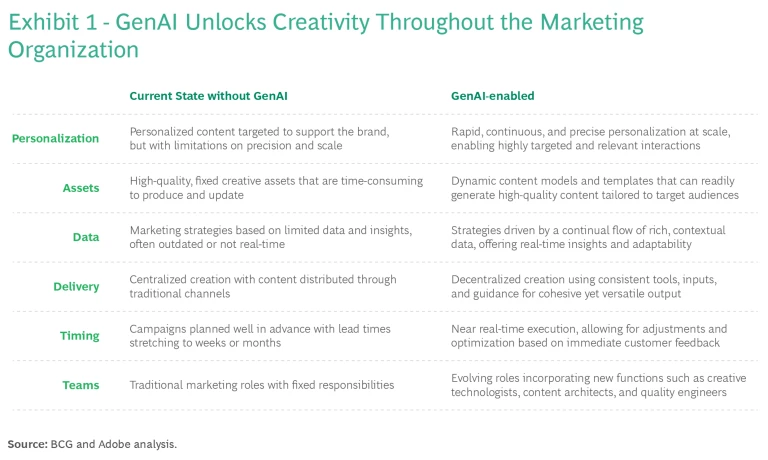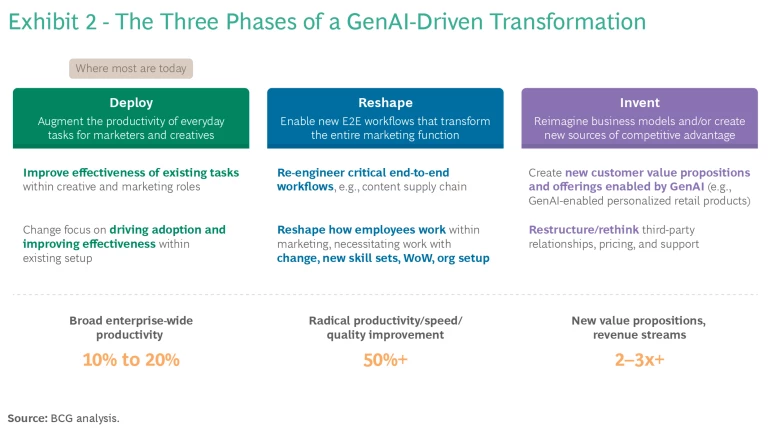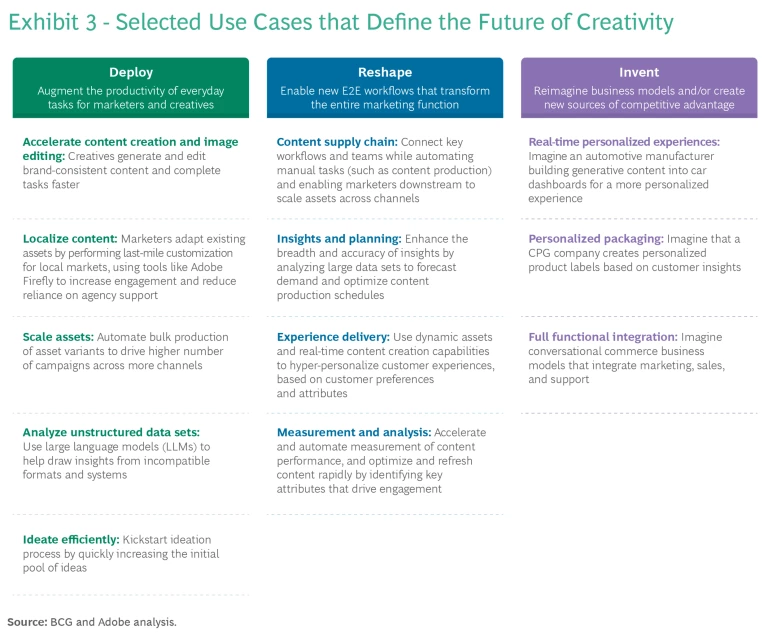As the use of generative AI (GenAI) continues to roll out across the business world, it raises questions about how this transformative technology will impact the creative process in marketing organizations. To truly unlock the full extent of GenAI’s power, marketers must answer one critical question: How will your organization transform when the marginal cost of creating and distributing content falls to near zero?
GenAI models have made remarkable strides over the past 18 months. Where early content-generation models produced strange images that were unsuitable for any serious marketing creative, current models are now generating professional quality images, video, voices, sound effects, music, and 3-D graphics in response to simple text instructions. And they do this in a matter of seconds at a tiny fraction of the current cost to produce similar content.
Low production costs are particularly important for video, which consumes the majority of content budgets. Video models coming available this year can now produce footage that is virtually indistinguishable from live action, but with the flexibility to imagine any subject in any location. GenAI tools can also rapidly create unique, royalty-free pieces of music for marketing campaigns. Voice models can generate voiceovers in any language, complete with regional dialects, offering a localized experience for global campaigns with less reliance on human voice actors.
This speed, flexibility, and cost efficiency will transform marketing organizations, changing the roles of people involved in content creation, when and where content creation takes place, and the tools, processes, and guidelines that enable and empower creators. It will, in fact, reshape the entire marketing function, from planning and insight generation to delivery and measurement. (See Exhibit 1.) In practice, BCG has seen clients realize up to 40% in non-working spend savings and a tenfold increase in the volume of content generated.

Beyond speed and cost efficiency, GenAI unlocks opportunities for content creators and marketers to operate at a macro-scale with micro-precision. Imagine AI tools that can draft engaging blog posts, craft compelling product descriptions, or generate interactive dialogues for chatbots—all tailored to the unique characteristics of the target audience. AI-driven text generators can adapt tone, style, and complexity based on user engagement metrics, making written content more effective and resonant with readers than ever before.
Longstanding practices in the creation of marketing content constrain creativity and limit the speed and scale of what an organization can deliver and the goals it can pursue. Marketing organizations cannot capitalize on the opportunities GenAI unlocks until they also unblock the ways that data, work, and ideas flow through the organization. At the same time, leaders must begin planning for deploying GenAI in a way that is commercially safe, responsible, ethical, and easy to adopt across teams.
Personalization at Scale Becomes the Standard, Not the Aspiration
High-quality content at near-zero marginal cost will enable marketing organizations to deliver on the promise of personalization at scale. Personalized product recommendations, promotions, and targeted communication already exist to some degree. Over the last decade, organizations made heavy investments in two key building blocks of at-scale personalization: data, via tools like customer data platforms, and customer journeys , via omnichannel decision-making and delivery tools tied to the data.
Despite these building blocks, organizations have faced a critical bottleneck: the inability to generate large amounts of personalized content. GenAI not only eliminates that bottleneck, but causes the equivalent of a dam break due to the sheer volume of content it allows an organization to create and distribute. Creative teams will continue to be essential in ideating and creating original content, but GenAI enables organizations to generate limitless variations of that content tailored to different contexts.
Creativity Becomes Data-Driven in Real Time
Historically, marketing organizations have used only a small fraction of customer data as a source for insights or creativity. The rapid decay of content value and insights has made it challenging to refresh and align with customer preferences. GenAI enables the execution of a truly data-informed marketing strategy .
With GenAI, marketing organizations can now iterate and refine ideas rapidly and more precisely based on real-time data tracking how content, offers, and experiences perform with individual consumers. In other words, a digital marketing campaign can now adapt images, tone, and composition based on consumer behavior in real time, enhancing the relevance, appeal, and effectiveness of creative output.
Marketing organizations can follow this path to speed and scale because they will no longer distribute fixed content assets to their local teams—and will instead provide the software, processes, and adaptable assets so these teams can generate content themselves. More easy-to-use creative tools, models, and templates in more hands supports the rapid generation and iteration of ideas. The upfront automation of tagging, sorting, and organizing marketing materials significantly speeds up campaign deployment and ensures localization or personalization.
Four Changes Coming Rapidly to Creativity in Marketing
As GenAI upends the marketing and creative process, we will see four major changes affecting practices, people, and organizations.
Marketers create more content at the point of experience.
The decentralization and democratization of content creation empowers marketers to experiment and manipulate campaign variables directly, fostering greater creativity and innovation in campaign design. A local team can use GenAI tools to work within a faster and tighter feedback loop that doesn’t require information to flow back to a central creative team. They can modify centrally created assets to fit their needs, create experiments, and quickly incorporate test results or other customer feedback to refine the content locally, all within strategic brand guidelines.
The Brazilian division of a global apparel company, for example, can create a product detail page that is personalized based on local consumer culture and preferences by leveraging central brand assets and using GenAI to derive localized production imagery. The local marketers have the final control, which means they can be more nimble to test and construct content that is more relevant for customers at the point of experience.
Creative roles become more strategic.
Creative teams will continue to be essential to ideate and create original content, but GenAI enables organizations to generate limitless variations of that content tailored to different contexts and audiences. This pursuit of greater personalization through GenAI will make some creative roles more efficient and others more strategic. The streamlining of labor-intensive tasks—such as graphic adjustments, bulk image resizing, basic video edits, transcreation, and preliminary content drafting—will allow creatives to focus on refining concepts and enhancing narratives and brand differentiation, which are critical functions that GenAI supports but does not replace. Creatives also can invest more time in defining the unique aspects of their brand’s voice and style, as well as testing creative concepts, which are essential for standing out in a crowded market.
Creative studios deliver models and templates, not fixed assets.
With less need for human creative production, creative studios and agencies will need to seize the opportunity to rethink their operating models. Their focus will shift from production to more strategic oversight and creative innovation, as they will increasingly deliver intellectual property (IP) in the form of models and templates versus finished assets. Agencies are positioned to serve as the custodians of brands’ custom models and templates, as well as leverage them downstream to drive personalized marketing and optimized media campaigns.
New marketing technology roles will emerge.
Our experience in implementing GenAI within marketing organizations has shown that success also requires new roles that will become increasingly influential. These roles include creative technologists, who work with creative teams to bridge the gap between creative goals and technological capabilities. Creative technologists will use GenAI tools to ensure that automated processes, data insights, and content variations are aligned with strategic marketing objectives. They will play a pivotal role in training creative teams on the best practices for integrating GenAI into their workflows and helping to troubleshoot complex challenges.
Quality engineers embedded in the creative studio are another new role. Their mission will be to ensure the quality, reliability, and compliance of outputs generated by GenAI tools. Additionally, dedicated security teams are essential to ensure the safe creation, storage, and distribution of this content. These teams should focus on a unified GenAI platform, allowing their organization to scale content securely and effectively.
Governance and Risk Management Loom Large
As GenAI reshapes creativity in marketing, responsible use of the technology is essential to scaling it successfully. Marketing organizations need to manage potential risks such as IP issues, copyright concerns, biases, and misinformation, and thoughtfully assess providers. For example, GenAI models that are trained only on properly licensed content can provide IP indemnity, ensure compliance, and safeguard customer trust.
Strong governance is essential to maintain quality, authenticity, and relevance as content production scales exponentially. The decentralization and democratization of GenAI-driven content creation necessitates robust guardrails to maintain brand integrity and prevent content saturation. Establishing strict controls, ethical standards, and monitoring systems ensures that each piece of content aligns with brand standards and identity across all platforms. Efforts such as the Content Authenticity Initiative and the Coalition for Content Provenance and Authenticity are emerging groups that are setting standards across the industry to mitigate misinformation and promote transparency on the origin of each piece of content.
The Future of Marketing Creativity Is Underway
BCG’s Deploy-Reshape-Invent framework describes the ways that creative and marketing organizations are using GenAI to transform themselves. (See Exhibit 2.) A recent survey of CMOs showed that over 84% of marketing organizations have deployed GenAI tools, a remarkable pace of rollout given the short time these tools have been on the market.

Organizations will realize the greatest value from GenAI, however, when they use it to redesign end-to-end workflows and invent new sources of competitive advantage. In a recent survey, 89% of leaders of organizations currently reshaping their functions anticipate a 200% to 400% increase in value generation over the next 12 months.
By comparison, the invent plays involve fundamental changes to how brands have conversations with their customers. It is currently unclear what many of those plays will look like, similar to how few could have forecast the form and influence of today’s social media back in the internet’s early days. Consequently, it’s difficult at this stage to forecast the extent of value growth from organizations’ invent efforts.
The full potential of GenAI remains largely untapped, in part because marketing technology ecosystems remain highly fragmented and workflows are built on legacy ways of working that include many manual handoffs, bespoke approvals, and lengthy cycle times. Our survey illustrated key concerns shared by leaders in moving beyond the simple deployment of GenAI tools. The respondents ranked people and processes (71%) as the most crucial factor to generating value, ahead of technology platform and tools (60%) and integrating company data (56%). But 63% of respondents highlighted the lack of the right expert personnel as the top challenge for scaling GenAI, and over 50% are deeply concerned about the complexities of incorporating GenAI, including issues like traceability and decision-making integrity.
Nonetheless, companies can accelerate their progress toward the future of creativity through the decisions they make now about how to get more out of their existing technologies, creative assets, and talent. Organizations have several straightforward, no-regrets opportunities to jumpstart their GenAI journeys, as the deploy column in Exhibit 3 shows.

Regardless of where they are on the GenAI marketing transformation journey, the brands that balance technology and human ingenuity will be the ones that create the most meaningful connections with end consumers. GenAI’s rapid pace of evolution means that marketing organizations cannot wait to see how tools develop before they deploy them. The best way to unlock the creative opportunities and unblock workflows is to start experimenting with GenAI so that the organization and its teams can learn and evolve at the pace of change.
The content was produced in collaboration with Adobe.










